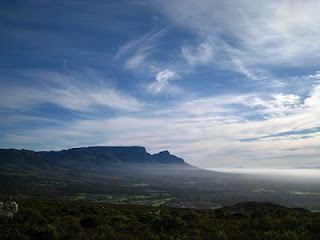
Fortunately the Pater of Noster blessed us with good weather in Paternoster. We had two days of blue skies and sunshine and at night the sea turned silver under the moon and splashed calmly onto the long beach in front of us.
But the story of today’s blog is about owls and a poet farmer. Sticking to the back roads from Velddrif to Hopefield and then to Darling, we noticed many wine barrels attached to the top of poles in fields. We wondered if they could be owls’ nests, but why so many? We stopped in front of a farmer’s gate and I convinced Jannie (who’s far more of a law-abiding citizen than me) that we should trespass 100m and check out a wine barrel. A small square hole had been cut out of the front and we stood there listening for chicks squeaking.
Silence. I picked up a pebble and threw it against the barrel. Silence. We walked back to the gate and then a small blue bakkie appeared on top of the hill. Soon it pulled up next to us and a young farmer with a beard, brown eyes and the shell of a small tortoise on a string around his neck, said: “Are you lost?” I noticed a canvas bag on the seat next to him and thought perhaps he was a farmer who drove around with a gun.
We explained that we were curious about the barrels on top of the poles. Yes, he said, they are indeed owls’ nests. He introduced himself as Johan “Planne” van Niekerk, a farmer from Darling.
He said because so much farmland has been cultivated, most barn owls (nonnetjies, as he called them in Afrikaans) have taken to the mountains, apart from those who have nested in barns.
With so few owls around there has been a plague of mice, who love the sandy soil. The mice became a big problem as they ate the wheat, sometimes clearing whole patches of land of wheat seed as it is sown. Then someone hit on the idea of putting up an owl’s nest, attracting more barn owls back to their original natural habitat.
“I’ve heard one nonnetjie can eat something like 25 mice an hour,” Planne said with a satisfied smile. “We have had some problems with bees or crows taking over the nests, but the farmers clean the nests out once a year,” Planne explained, then leaned towards the open window on the passenger side. “But why are you guys so far on the back roads? What do you do?”
I said I was a writer. Planne, still sitting in his bakkie, said: “A writer!” Then he became quite shy. “Actually, I write poetry. Ag man, I just write about the feelings I have sometimes about farming and so on.” Now even more shy, he opened the canvas bag (the one I thought had a gun in) and said, “I have my poems here”. He took out two notebooks and started paging through them. He had written in a neat long hand in blue ink, sometimes crossing out sections. The whole notebook was full of poetry.
“I’ll read some to you,” he said.
Then, with sheep grazing next to the road on this late Sunday afternoon, the farmer sat behind his steering wheel and read his poems. They were about the bitter aloes that flower like orange flames in a raw winter when everything else has gone wrong. About the way your horse’s sweat seeps onto your skin through your jeans’ seams when you are driving your sheep and cattle up to the winter pastures and how the dry road cracks under the horse’s feet.
And then about his love for a girl who had cancer and what he had seen in her eyes.
Then his cellphone - an iPhone - rang. We said goodbye and so did he.

 Something strange greeted us in the east when we woke up on Sunday morning. It was the sun. Almost unseen for the past two weeks, it made its re-appearance with a mad jumble of red and pink clouds streaked across the horizon. Every last shred of grey rain and cold was gone. It was a beautiful day.
Something strange greeted us in the east when we woke up on Sunday morning. It was the sun. Almost unseen for the past two weeks, it made its re-appearance with a mad jumble of red and pink clouds streaked across the horizon. Every last shred of grey rain and cold was gone. It was a beautiful day.




 Ceps have a thick layer of sponge underneath them, also making it a dead cert once you know what it looks like. Everyone knows the story of old mushroom hunters and bold mushroom hunters, but no old, bold mushroom hunters. We are not old and we are not bold, so we’re taking no chances.
Ceps have a thick layer of sponge underneath them, also making it a dead cert once you know what it looks like. Everyone knows the story of old mushroom hunters and bold mushroom hunters, but no old, bold mushroom hunters. We are not old and we are not bold, so we’re taking no chances. 